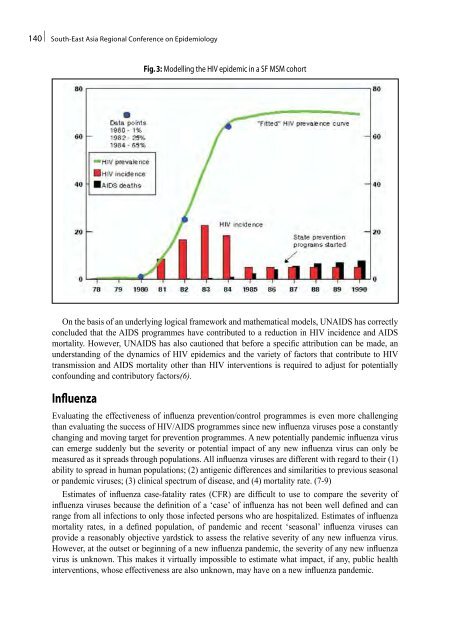South-East Asia Regional Conference on Epidemiology
South-East Asia Regional Conference on Epidemiology
South-East Asia Regional Conference on Epidemiology
You also want an ePaper? Increase the reach of your titles
YUMPU automatically turns print PDFs into web optimized ePapers that Google loves.
140 | <str<strong>on</strong>g>South</str<strong>on</strong>g>-<str<strong>on</strong>g>East</str<strong>on</strong>g> <str<strong>on</strong>g>Asia</str<strong>on</strong>g> <str<strong>on</strong>g>Regi<strong>on</strong>al</str<strong>on</strong>g> <str<strong>on</strong>g>C<strong>on</strong>ference</str<strong>on</strong>g> <strong>on</strong> <strong>Epidemiology</strong><br />
Fig. 3: Modelling the HIV epidemic in a SF MSM cohort<br />
On the basis of an underlying logical framework and mathematical models, UNAIDS has correctly<br />
c<strong>on</strong>cluded that the AIDS programmes have c<strong>on</strong>tributed to a reducti<strong>on</strong> in HIV incidence and AIDS<br />
mortality. However, UNAIDS has also cauti<strong>on</strong>ed that before a specific attributi<strong>on</strong> can be made, an<br />
understanding of the dynamics of HIV epidemics and the variety of factors that c<strong>on</strong>tribute to HIV<br />
transmissi<strong>on</strong> and AIDS mortality other than HIV interventi<strong>on</strong>s is required to adjust for potentially<br />
c<strong>on</strong>founding and c<strong>on</strong>tributory factors(6).<br />
Influenza<br />
Evaluating the effectiveness of influenza preventi<strong>on</strong>/c<strong>on</strong>trol programmes is even more challenging<br />
than evaluating the success of HIV/AIDS programmes since new influenza viruses pose a c<strong>on</strong>stantly<br />
changing and moving target for preventi<strong>on</strong> programmes. A new potentially pandemic influenza virus<br />
can emerge suddenly but the severity or potential impact of any new influenza virus can <strong>on</strong>ly be<br />
measured as it spreads through populati<strong>on</strong>s. All influenza viruses are different with regard to their (1)<br />
ability to spread in human populati<strong>on</strong>s; (2) antigenic differences and similarities to previous seas<strong>on</strong>al<br />
or pandemic viruses; (3) clinical spectrum of disease, and (4) mortality rate. (7-9)<br />
Estimates of influenza case-fatality rates (CFR) are difficult to use to compare the severity of<br />
influenza viruses because the definiti<strong>on</strong> of a ‘case’ of influenza has not been well defined and can<br />
range from all infecti<strong>on</strong>s to <strong>on</strong>ly those infected pers<strong>on</strong>s who are hospitalized. Estimates of influenza<br />
mortality rates, in a defined populati<strong>on</strong>, of pandemic and recent ‘seas<strong>on</strong>al’ influenza viruses can<br />
provide a reas<strong>on</strong>ably objective yardstick to assess the relative severity of any new influenza virus.<br />
However, at the outset or beginning of a new influenza pandemic, the severity of any new influenza<br />
virus is unknown. This makes it virtually impossible to estimate what impact, if any, public health<br />
interventi<strong>on</strong>s, whose effectiveness are also unknown, may have <strong>on</strong> a new influenza pandemic.









